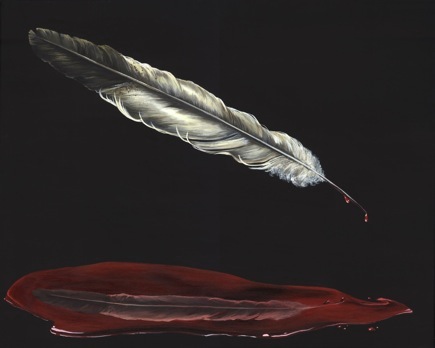Copyright © 2005 Abraham Studios
Send mail to abrahamart@gmail.com with questions or comments about this site.








Copyright © 2005 Abraham Studios
Send mail to abrahamart@gmail.com with questions or comments about this site.
December 29, 1890
South Dakota-inspired
30 x 24"
acrylic on canvas
Upfront Gallery, Fargo, ND
$1300
A pulse in my stomach climbs to my tightening throat. Identity lost, future erased. Final sensations of hope numbed. Fingers turn purple, and mind fades away. I see hands curl gently in front of me, but they are not my own. They are a resident of the Black Hills.
Tears dried up two days foregoing. Cracked skin, and aching souls mourn. This ends. You shall never again remove the cloth from those bony shoulders of yours. This ends. That ounce of love once left has been swallowed into hate. Smiles no more. Retreat. Just retreat into this earth, and finally claim the land as your own. No victory is to be had. No success to be made. You are one of many, left filling a mass grave. You follow him there, evil warden of yours. They search that hollow body, finding nothing left inside. No longer a ghost dancer, you today became the dance.
A world forever changed by one bloody day in December. Tears travel over red skin, like a river weaving through cracked clay. Frozen images burn deeply in the minds of all, remembering the sacrifice made on that twenty-ninth day.
Colonel Forsyth and his 7th Calvary claimed the lives of 84 Lakota men, 44 women and 18 children upon disarming them. A burial party returned to the sight after a snowstorm and placed the frozen and contorted bodies into a mass grave. Wrapped in the shawls of their dead mothers, four infants were found alive. Response to the event was mostly positive from the American public, despite accusations of massacre. Twenty medals of Honor were awarded, and the Aberdeen Saturday Pioneer responded on January 3rd 1891 with:
"The Pioneer has before declared that our only safety depends upon the total extermination of the Indians. Having wronged them for centuries, we had better, in order to protect our civilization, follow it up by one more wrong and wipe these untamed and untamable creatures from the face of the earth. In this lies future safety for our settlers and the soldiers who are under incompetent commands. Otherwise, we may expect future years to be as full of trouble with the redskins as those have been in the past."
We are surprised to find out that the author of this article was a young editor named L. Frank Baum, who later went on to write The Wonderful Wizard of Oz.
This story takes on a deeper significance as I stand here with the Oglala Sioux. There is no extravagant memorial, nor neatly engraved plaques. Only a faded sign at the edge of the road, and a modestly built kiva sit beside the hill of graves. The sign reads “Massacre of Wounded Knee,” but the word “Massacre” is on a wooden board, tacked over the original title. We enter the round building and find a dark-haired woman sweeping a dirt floor. Her child runs circles around her, and we ask why there is a board nailed over the title of the government issued sign. “It used to read ‘Battle of Wounded Knee,’” she replies. Cracked walls are adorned with memories of fallen “freedom fighters,” quotes, timelines and epitaphs. The room is humid and unventilated. The little girl, whose name we learn is “Feather,” has found a place on the floor to make bracelets. We thank them both, and walk to the cemetery. I approach the plot, marked by sticks and colorful weavings, and suddenly feel ashamed by the color of my skin.










